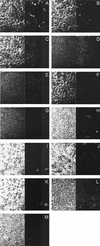Characterization of human class-switched polymeric (immunoglobulin M [IgM] and IgA) anti-human immunodeficiency virus type 1 antibodies 2F5 and 2G12
- PMID: 12634368
- PMCID: PMC150633
- DOI: 10.1128/jvi.77.7.4095-4103.2003
Characterization of human class-switched polymeric (immunoglobulin M [IgM] and IgA) anti-human immunodeficiency virus type 1 antibodies 2F5 and 2G12
Abstract
We have previously generated human monoclonal anti-human immunodeficiency virus type 1 (anti-HIV-1) antibodies 2F5IgG and 2G12IgG with an exceptional cross-clade neutralizing potential. 2F5IgG and 2G12IgG passively administrated to macaques were able to confer complete protection from both intravenous and mucosal challenge with pathogenic HIV-simian immunodeficiency virus chimeric strains and have shown beneficial effects in a phase-1 clinical trial. We now class-switched 2F5 and 2G12 to the immunoglobulin M (IgM) or IgA isotype, to enforce features like avidity, complement activation, or the potential to neutralize mucosal transmission. For this purpose we expressed functional polymeric 2F5 and 2G12 antibodies in CHO cells and evaluated their anti-HIV-1 activity in vitro. The class switch had a strong impact on the protective potential of 2F5 and 2G12. 2G12IgM inhibited HIV-1 infection of peripheral blood mononuclear cell cultures up to 28-fold-more efficiently than the corresponding IgG and neutralized all of the primary isolates tested. The 2F5 and 2G12 antibodies of all isotypes were able to interact with active human serum to inhibit viral infection. Furthermore, we demonstrated that polymeric 2F5 and 2G12 antibodies but not the corresponding IgGs could interfere with HIV-1 entry across a mucosal epithelial layer in vitro. Although polymeric 2F5 antibodies had only limited potential in the standard neutralization assay, the results from the mucosal assay suggest that 2F5 and 2G12 antibodies may have a high potential to prevent natural HIV-1 transmission in vivo.
Figures





References
-
- Alfsen, A., P. Iniguez, E. Bouguyon, and M. Bomsel. 2001. Secretory IgA specific for a conserved epitope on gp41 envelope glycoprotein inhibits epithelial transcytosis of HIV-1. J. Immunol. 166:6257-6265. - PubMed
-
- Baba, T. W., V. Liska, R. Hofmann-Lehmann, J. Vlasak, W. Xu, S. Ayehunie, L. A. Cavacini, M. R. Posner, H. Katinger, G. Stiegler, B. J. Bernacky, T. A. Rizvi, R. Schmidt, L. R. Hill, M. E. Keeling, Y. Lu, J. E. Wright, T. C. Chou, and R. M. Ruprecht. 2000. Human neutralizing monoclonal antibodies of the IgG1 subtype protect against mucosal simian-human immunodeficiency virus infection. Nat. Med. 6:200-206. - PubMed
-
- Battle-Miller, K., C. A. Eby, A. L. Landay, M. H. Cohen, B. E. Sha, and L. L. Baum. 2002. Antibody-dependent cell-mediated cytotoxicity in cervical lavage fluids of human immunodeficiency virus type 1-infected women. J. Infect. Dis. 185:439-447. - PubMed
-
- Bomsel, M. 1997. Transcytosis of infectious human immunodeficiency virus across a tight human epithelial cell line barrier. Nat. Med. 3:42-47. - PubMed
Publication types
MeSH terms
Substances
LinkOut - more resources
Full Text Sources
Other Literature Sources
Miscellaneous

